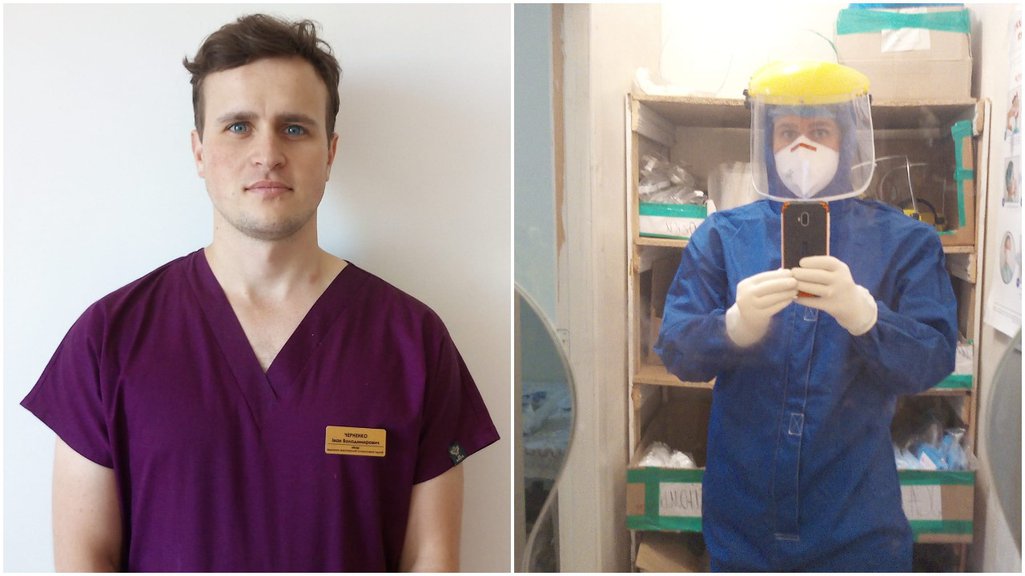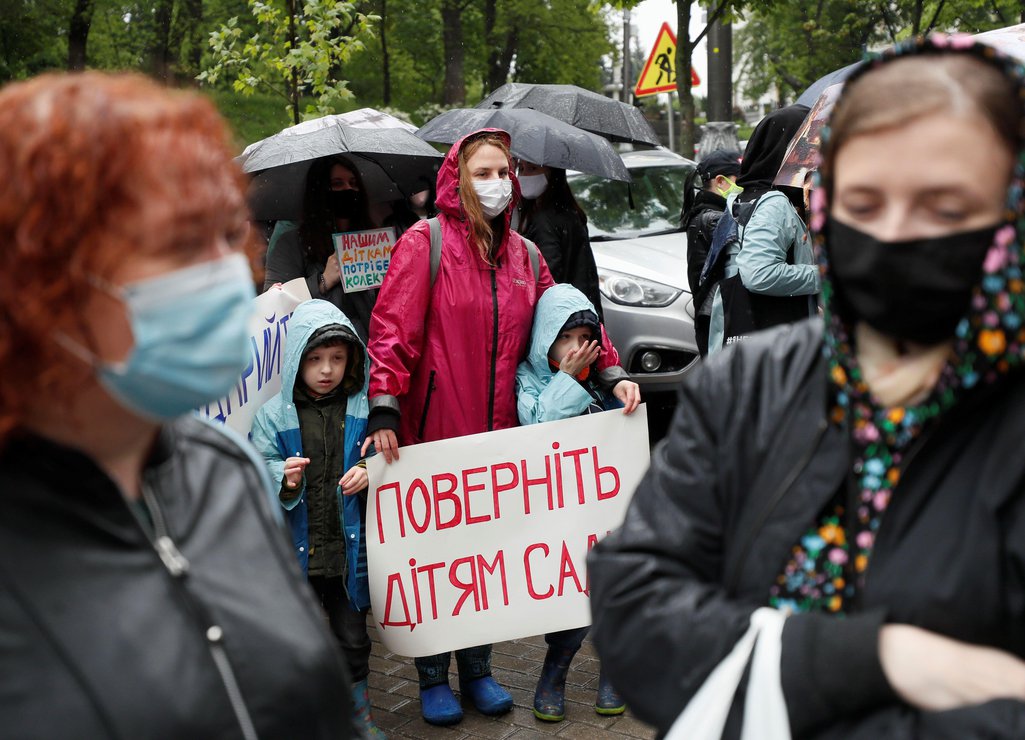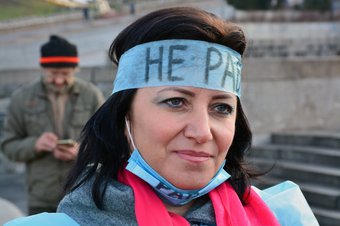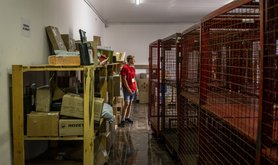
“We are constantly one step behind”: Inside Ukraine’s third wave
One volunteer spoke of living in 'two parallel worlds', with 'hellish' conditions for medical workers but a lax attitude from many citizens

“We cannot take light or moderate patients, which leads to conflicts: calls to hotlines, calls to deputies. But your social status and money aren’t important here. We’ll still take someone who really needs oxygen.”
It’s the evening of 2 April. I’m sitting in my kitchen in Ukraine’s capital, Kyiv, and talking to Ivan Chernenko, an anaesthesiologist some 300 miles to the south in the port city of Odesa. He’s on duty now, at the central regional hospital, and there’s less work, he says, after five pm.
That said, our interview is interrupted several times as Chernenko needs to tend to his patients. “I have to answer them, wait a minute,” he says and hangs up.
“The marathon of shifts has begun,” he wrote a few days later on Facebook, where he regularly describes his work to thousands of readers. “There goes April down the drain.”

At the beginning of the month, a strict lockdown was introduced across a number of Ukrainian cities, including Kyiv and Odesa – now designated “red zones” in terms of their coronavirus infection rates. Schools, kindergartens, cafes and restaurants are not open, and you can take public transport and the metro only with a special travel permit. On 3 April, the number of new recorded infections in Ukraine reached more than 20,341 people per day.
“At the end of February, we were completely empty, then new cases began to appear from 12-13 March,” Chernenko says. “It was very fast, five to six new admissions a day. We literally filled up in two weeks. All the patients who are currently hospitalised are patients who require oxygen support, or with decompensated chronic diseases. In principle, [they are] difficult patients.”
That the number of patients would increase in the first week of February was predicted by analysts from the Kyiv School of Economics.
According to their calculations, since the beginning of January in the country’s western regions of Ivano-Frankivsk, Chernivtsi and Transcarpathia, 1.2-1.5 times more people have been hospitalised than discharged, which indicates a high risk of new outbreaks of the disease. Researchers also pointed to the fact that “it is patients with high and moderate severity of the disease that create a burden on hospitals”. The analysts’ forecast turned out to be real – and the third wave soon began in Ukraine, a fact confirmed by health minister Maksym Stepanov on 13 April.
“As we predicted, we’ve reached the peak of infection,” Stepanov said, noting that the infection rate was beginning to drop. “And now the situation is starting to stabilise. We see this across all of the country’s regions.”

Yuri Hanychenko, a senior researcher at the Kyiv School of Economics, says that the number of detected cases consists of two numbers: the real number of people who have fallen ill multiplied by the percentage of cases actually identified.
“Let’s imagine that the real number of cases is 100 people. Yesterday, 30 of them were found, and today 70. This growth seems to double out of the blue. This number strongly depends on how many cases are found. In Ukraine, the problem is how infected persons are identified. The number of detected cases can jump up: if the testing rate increases, so does the number of cases,” says Hanychenko, who believes the rate at which people are hospitalised should also be taken into account.
“If the rate of hospitalisation goes down, it’s a good sign. In order to make informed decisions in the country, you need to understand what is happening with the rate of infection. Therefore, our recommendation was to move from the number of cases to the rate of hospitalisation [as a deciding factor]. The state listened, and now we have the hospitalisation rate, including fluctuations, in our quarantine indicators.”
‘Living in this hell’
The Monsters Corporation charity in Odesa is also fighting the third wave. Founded in 2014, the organisation, led by volunteer Kateryna Nozhevnikova, was originally set up to help orphans from Luhansk, then in the midst of war, settle in Odesa. Now the charity is helping provide oxygen concentrators in their native city and beyond.
“I’m not superstitious at all, but I monitor the situation and know our hospitals from the inside for many, many years. It was clear that mechanical ventilation was needed, but not in that amount,” says Nozhevnikova. “We started buying oxygen in July and I queued up wherever possible. There were very big supply disruptions and it was almost impossible to buy oxygen.”
There’s outrage in Nozhevnikova’s voice when she talks about how citizens adhere to quarantine measures in Odesa. “There are still arguments on the internet about how the virus is not real. It’s like we’re in two parallel worlds: I am at work, living in this hell, then I go out into the city and you think everything is fine, nothing is happening.”
Nozhevnikova says she never complains: it’s her choice to do what she does. But as we talk, the volunteer says that she is very tired – physically and mentally. “It’s very hard to listen when a 30-year-old man calls you and you cannot help. When patients call you and say their dad is dead, their son is dead, their brother is dead – it’s very hard.”

Ivan Chernenko claims that after a certain number of patients fall ill in the spring, a new subgroup of people with immunity will form, the transmission chain will be broken and incidence rates will decrease. But in the summer, when Ukraine’s holiday season begins, he says everything will start over.
“Nobody is going to cancel the holiday season,” he explains. “We are again losing that margin of safety. Our main problem is that all decisions are short-sighted. We are used to solving problems as they come, and this is our big trouble. [...] We are constantly one step behind the epidemic.”
The prospect of vaccination in Ukraine is slim: on the one hand, state agencies have found it difficult to procure vaccines at the necessary rate or on time – and on the other, as in much of Europe, there’s widespread scepticism towards vaccination and COVID more generally. According to a recent EU-funded survey, 61% of respondents in Ukraine said they were ready to get vaccinated, compared to 66% in Italy.
As we are talking, I can hear Chernenko addressing someone in the hospital. “Open the bottle... Oh I thought you were changing it,” the anesthesiologist says and returns to our conversation.
“We ran out of oxygen here, now I’m going to switch the cylinders. This is one of the jobs of the person on duty: to run around changing cylinders. We have cylinders, we have concentrators.”
But while Ukraine’s doctors currently receive 300% of their salaries as a COVID bonus, they are very tired, Chernenko says: in addition to COVID-19, there are other patients who need to be treated, too.
“In reality, we can’t leave and we have no right to get sick,” he says.
Related story
Read more
Get our weekly email





Comments
We encourage anyone to comment, please consult the oD commenting guidelines if you have any questions.